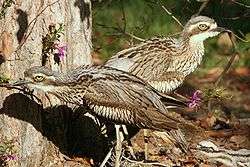Bush stone-curlew
| Bush stone-curlew | |
|---|---|
 | |
| In Cairns, Australia | |
| Scientific classification | |
| Kingdom: | Animalia |
| Phylum: | Chordata |
| Class: | Aves |
| Order: | Charadriiformes |
| Family: | Burhinidae |
| Genus: | Burhinus |
| Species: | B. grallarius |
| Binomial name | |
| Burhinus grallarius (Latham, 1801) | |
The bush stone-curlew or bush thick-knee (Burhinus grallarius, obsolete name Burhinus magnirostris) is a large (55–60 cm wingspan),[2] ground-dwelling bird endemic to Australia. Although it looks rather like a wader and is related to the oystercatchers, avocets and plovers, it is a terrestrial predator filling an ecological niche similar to that of the roadrunners of North America.
Taxonomy
The bush stone-curlew was first described by the English ornithologist John Latham in 1801 under the binomial name Charadius grallarius.[3]
Description
Like most stone-curlews, it is mainly nocturnal and specialises in hunting small grassland animals: frogs, spiders, insects, molluscs, crustaceans, snakes, lizards and small mammals are all taken, mostly gleaned or probed from soft soil or rotting wood; also a few seeds or tubers, particularly in drought years. Birds usually forage individually or in pairs over a large home range, particularly on moonlit nights.
During the day, bush stone-curlews tend to remain inactive, sheltering amongst tall grass or low shrubs and relying on their cryptic plumage to protect them from predators. When disturbed, they freeze motionless, often in odd-looking postures. For visual predators like raptors (and humans), this works well, but it serves little purpose with animals that hunt by scent such as foxes, dingoes or goannas.
Despite their ungainly appearance and habit of freezing motionless, they are sure-footed, fast and agile on the ground, and although they seldom fly during daylight hours, they are far from clumsy in the air; flight is rapid and direct on long, broad wings.
The bush Stone-curlew is probably heard more than it is seen. Its call sounds like a wail or a scream in the night. When scared, it screeches – a sound similar to the screech of a possum.[4] When threatened (presumably in the presence of a nest), they may raise their wings wide and high in an impressive threat posture and emit a loud, hoarse hissing noise.
Distribution and habitat
The bush stone-curlew has a broad habitat preference, it can be found in open forest, eucalyptus woodland, rainforest edges, grassy plains, arid scrubland and along inland watercourses. It is a common species in the cities of Brisbane, Cairns and Townsville however is not found in urban areas in the south of its range. It can be found throughout Australia apart from the West Australian coast and Tasmania. It is still abundant in the tropical and sub-tropical north, however has become very rare in the less fertile south where it was once common.
Conservation status


Bush stone-curlews remain reasonably common in the north of Australia, but have become rare in the less fertile south. Many experts believe that fox predation is a prime factor in their decline, however there are areas where foxes are common yet the bush stone-curlew population remains healthy, so the true causes remain uncertain. Large-scale habitat destruction and fragmentation has undoubtedly been important, and may well be the major factor, although there is some evidence that suggests that the species clearly favours agricultural land with patches of remnant native vegetation over intact areas of vegetation.[5]
Bush stone-curlew is not listed as threatened on the Environment Protection and Biodiversity Conservation Act 1999. It is common in Queensland, and not considered to be regionally threatened there. In New South Wales it is considered endangered under the Threatened Species Conservation Act 1995. Bush Stone Curlew are listed as "threatened" on the Victorian Flora and Fauna Guarantee Act 1988.[6] Under this Act, an Action Statement for the recovery and future management of this species has been prepared.[7] On the 2007 advisory list of threatened vertebrate fauna in Victoria, this species is listed as endangered.[8]
 Chicks in cryptic pose
Chicks in cryptic pose Adult facial markings
Adult facial markings Pair
Pair At Perth Zoo, Australia
At Perth Zoo, Australia
References
| Wikimedia Commons has media related to Burhinus grallarius. |
| Wikispecies has information related to: Burhinus grallarius |
- ↑ BirdLife International (2012). "Burhinus grallarius". IUCN Red List of Threatened Species. Version 2013.2. International Union for Conservation of Nature. Retrieved 26 November 2013.
- ↑ Morcombe, Michael (2000). Field Guide to Australian Birds. Box 1058, Archerfield, Qld: Steve Parish Publishing. p. 128. ISBN 174021417X.
- ↑ Latham, John (1801). Supplementum indicis ornithologici sive systematis ornithologiae (in Latin). London: Leigh & Sotheby. p. lxvi.
- ↑ Denise Lawungkurr Goodfellow (2005). Birds of Australia's Top End. Frenchs Forest, New South Wales: Reed New Holland. p. 68. ISBN 1-877069-19-1.
- ↑ Gates, J.A.; Paton, D.C. (2005). "The distribution of Bush Stone-curlews (Burhinus grallarius) in South Australia, with particular reference to Kangaroo Island". Emu. 105 (3): 241–247. doi:10.1071/MU02029.
- ↑ "Department of Sustainability and Environment, Victoria". Archived from the original on 2005-07-18. Retrieved 2007-09-19.
- ↑ "Department of Sustainability and Environment, Victoria". Archived from the original on 2006-09-11. Retrieved 2007-01-16.
- ↑ Victorian Department of Sustainability and Environment (2007). Advisory List of Threatened Vertebrate Fauna in Victoria – 2007. East Melbourne, Victoria: Department of Sustainability and Environment. p. 15. ISBN 978-1-74208-039-0.
